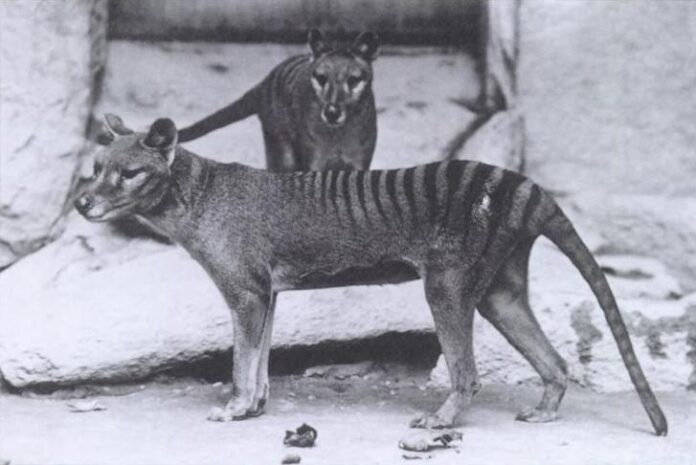Ever changing environment leads to extinction of the animals unfit to survive in the changed environment and favours survival of the fittest which culminate in evolution of a new species. However, thylacine (commonly known as Tasmanian tiger or Tasmanian wolf), a marsupial carnivore mammal indigenous to Australia that became extinct about a century ago, not due to natural process of organic evolution, but due to human influence may become de-extinct and live again in about a decade time. Last living thylacine died in 1936 but luckily, many embryos and young specimens were found suitably preserved in the museums. Thylacine genome has already been successfully sequenced using thylacine DNA extracted from 108-year-old specimen preserved at the Victoria Museum in Australia. The research team has recently tied up with a biotech firm to accelerate the efforts of resurrection.
University of Melbourne’s Thylacine Integrated Genomic Restoration Research (TIGRR) Laboratory has partnered with Colossal Biosciences, a genetic engineering company to accelerate efforts to resurrect Tasmanian tiger (Thylacinus cynocephalus). Under the arrangement, TIGRR Lab of the University will focus on establishing the reproductive technologies tailored to Australian marsupials, such as IVF and gestation without a surrogate, while Colossal Biosciences will provide their CRISPR gene editing and computational biology resources to reproduce thylacine DNA.
The thylacine (Thylacinus cynocephalus) is an extinct carnivorous marsupial mammal that was native to the Australia. It was known as Tasmanian tiger due to its stripped lower back. It had dog-like appearance hence was also known as Tasmanian wolf.
It disappeared from Australian mainland around 3000 years ago due to hunting by humans and competition with dingoes but a population thrived on the island of Tasmania. Their number in Tasmania started dwindling with the arrival of European settlers who systematically persecuted them for suspicion of killing livestock. As a result, thylacine became extinct. The last thylacine died in captivity in 1936.
Unlike many extinct animals like dinosaurs, the thylacine did not become extinct due to natural process of organic evolution and natural selection. Their extinction was human caused, a direct result of hunting and killing by the people in the recent past. Thylacine was apex predator in the local food chain thus responsible for stabilising ecosystem. Also, Tasmanian habitat is relatively unchanged since thylacine became extinct so when re-introduced they can easily reoccupy their niche. All these factors make thylacine a fit candidate for de-extinction or resurrection.
Genome sequencing is the first and extremely crucial step in the de-extinction effort. The last thylacine had died in 1936 however many embryos and young specimens were found preserved in suitable media in museums. TIGRR Lab was able to extract DNA of thylacine from 108-year-old specimen preserved at the Victoria Museum in Australia. Using this extracted DNA, thylacine genome was sequenced in 2018 and updated in 2022.
Sequencing of thylacine genome is followed by sequencing genome of dunnart and identify differences. Dunnart is a close genetic relative of thylacine belonging to family dasyuridae, in whose egg nucleus from Thylacine-like cell will be transferred.
Next step is creation of ‘thylacine-like cell’. With the help of CRISPR and other genetic engineering technologies, thylacine genes will be inserted into Dasyurid genome. This will be followed by transfer of nucleus of thylacine-like-cell to an enucleated Dasyurid egg using somatic cell nuclear transfer (SCNT) technology. The egg with the transferred nucleus will act as zygote and grows to become embryo. Embryonic growth is promoted in vitro until it becomes ready for transfer to surrogate. Developed embryo will then be implanted into surrogate followed by standard steps of gestation, maturation and birth.
Notwithstanding remarkable advances in genetic engineering and reproduction technologies, resurrection of an extinct animal is still an almost impossible challenge. Many things are in favour of thylacine de-extinction project; perhaps the most important factor is successful extraction of thylacine DNA from a preserved museum specimen. Rest is technology. In the case of animals like dinosaurs, de-extinction is impossible simple because there is no way to extract useful dinosaur DNA to sequence dinosar genome.
***
Sources:
- University of Melbourne 2022. News – Lab takes ‘giant leap’ toward thylacine de-extinction with Colossal genetic engineering technology partnership. Posted 16 August 2022. Available at https://www.unimelb.edu.au/newsroom/news/2022/august/lab-takes-giant-leap-toward-thylacine-de-extinction-with-colossal-genetic-engineering-technology-partnership2
- Thylacine Integrated Genomic Restoration Research Lab (TIGRR Lab) https://tigrrlab.science.unimelb.edu.au/the-thylacine/ & https://tigrrlab.science.unimelb.edu.au/research/
- Thylacine https://colossal.com/thylacine/
***






































